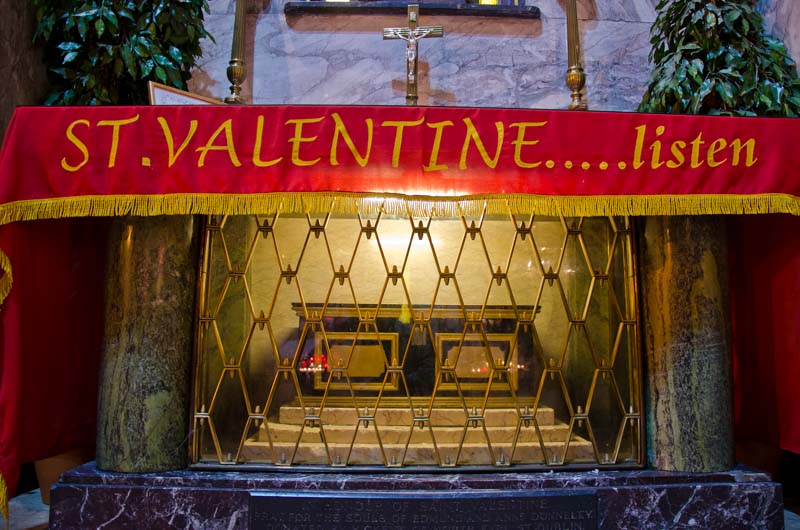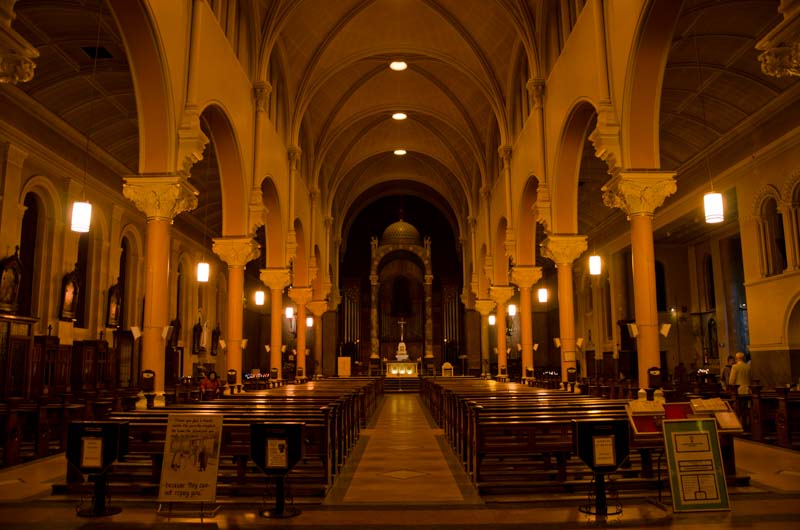Whitefriar Street Carmelite Church
The tomb of St. Valentine in Dublin
 Saint Valentine's tomb in the Whitefrairs Chruch of St. Mary of Mount Carmel, Dublin
Saint Valentine's tomb in the Whitefrairs Chruch of St. Mary of Mount Carmel, Dublin

The nave of the Whitefriars Carmelite Church in Dublin.
The only reason to come to this rather bland church in the southern part of Dublin's city center is to see the tomb of St. Valentine.
Yes, that St. Valentine, of Valentine's Days fame.
Oddly, however, little fuss is made over the tomb of this wordlwide famous saint. Virtually unsung in guidebooks—and hence unknown to most visitors—this church is (understandably) very popular in among Dubliners for weddings.
The tomb of St. Valentine
The tomb of St. Valentine is a surprisingly modest, modern affair in a chapel off the right aisle. There is a red cloth draped over the altar above the tomb, and a glass frontal so you can see the modest tomb itself.
How did a third-century Roman saint like Valentine end up in Dublin?
Well, like most major, brand-name saints, not all of St. Valentine is actually here. His skull is in Santa Maria in Cosmedin in Rome, and other churches around Europe claim to have other bits of him.
However, in 1836 Pope Gregory XVI gifted the bulk of the Valentine relics—including a vial "tinged with his blood"—to a popular Dublin-born preacher named Fr. John Spratt, who had re-founded this church in the 1820s and apparently gave a barn-raising sermon while visiting Rome that inspired Gregory to his largess with Vatican relics.
This holy site predates Dublin itself
Though the current structure was built in the 1820s—and expanded in the 1840s, and again in the 1950s—this church does occupy the same real estate of a long-vanished Carmelite priory from the 13th century (Suppressed in 1539).
Even more intriguingly, that Priory was built very near the site of a small Celtic Christian monastery that flourished by the River Poddle long before the Vikings established their fort and port just downstream at the dubh linn (dark pool) made by the Poddle just before its confluence with the River Liffey.
This fort would grow into Dublin Castle and become the nucleus of the city of Dublin—but the older monastic community on this site was actually the first settlement in the Dublin area (at least in the modern age).
Tips
- Planning your time: It takes all of five minutes to wander in, see the tomb, take the obligatory picture (or smooching selfie), and wander out.
- Mass: Sunday: 8, 10:30, and 11:30am, 12:30, 4, and 7pm. Weekdays: 8, 10, and 11:30am, 1:10 and 3pm. Saturday vigil: 6pm.
Related Articles |
Related Partners
|
This article was by Reid Bramblett and last updated in September 2011.
All information was accurate at the time.
Copyright © 1998–2013 by Reid Bramblett. Author: Reid Bramblett.
56 Aungier Street
Dublin 2
Tel. +353-(0)1/475-8821
whitefriarstreetchurch.ie
OPEN
Mon-Fri 8:30am–6pm (Tues to 8:15pm); Sat 9:30am–6pm; Sun 8am–4pm.
ADMISSION
Admission: Free
TRANSPORT
Bus: 9, 16, 16C, 65, 65B, 68, 68A, 83, 83A, 122
LUAS: St. Stephen's Green
DART:Pearse
